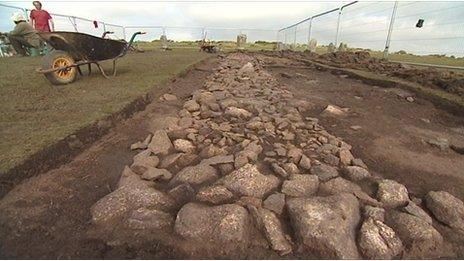Hurlers stone circles pathway uncovered on Bodmin Moor
- Published

The dig was a community archaeological project with local people and enthusiasts helping the experts
A Bronze Age stone pathway that links stone circles has been uncovered for the first time since the 1930s.
Archaeologists were helped by local people to "re-discover" the feature, laid between two of the Hurlers stone circles on Bodmin Moor, Cornwall.
The 4,000-year-old pavement has been described as "unique" by archaeologists.
They hope it will give a better understanding of early civilisations.
The causeway was first uncovered more than 70 years ago, when workmen stabilised the site and re-erected a number of stones.
But its existence only came to light again when Cornish archaeologist, Jacky Nowakowski, found a reference to it in an unpublished report from the Ministry of Works' excavation of the Hurlers.
The Hurlers are a close grouping of three late Neolithic or early Bronze Age stone circles.
The excavation is part of a wider project organised by the Caradon Hill Area Heritage Project called "Mapping the Sun".
The dig will be led by a team from Cornwall Council's historic environment department.
After seven days of digging, the pavement will be re-covered to protect and preserve it.
- Published3 September 2011
- Published7 May 2011